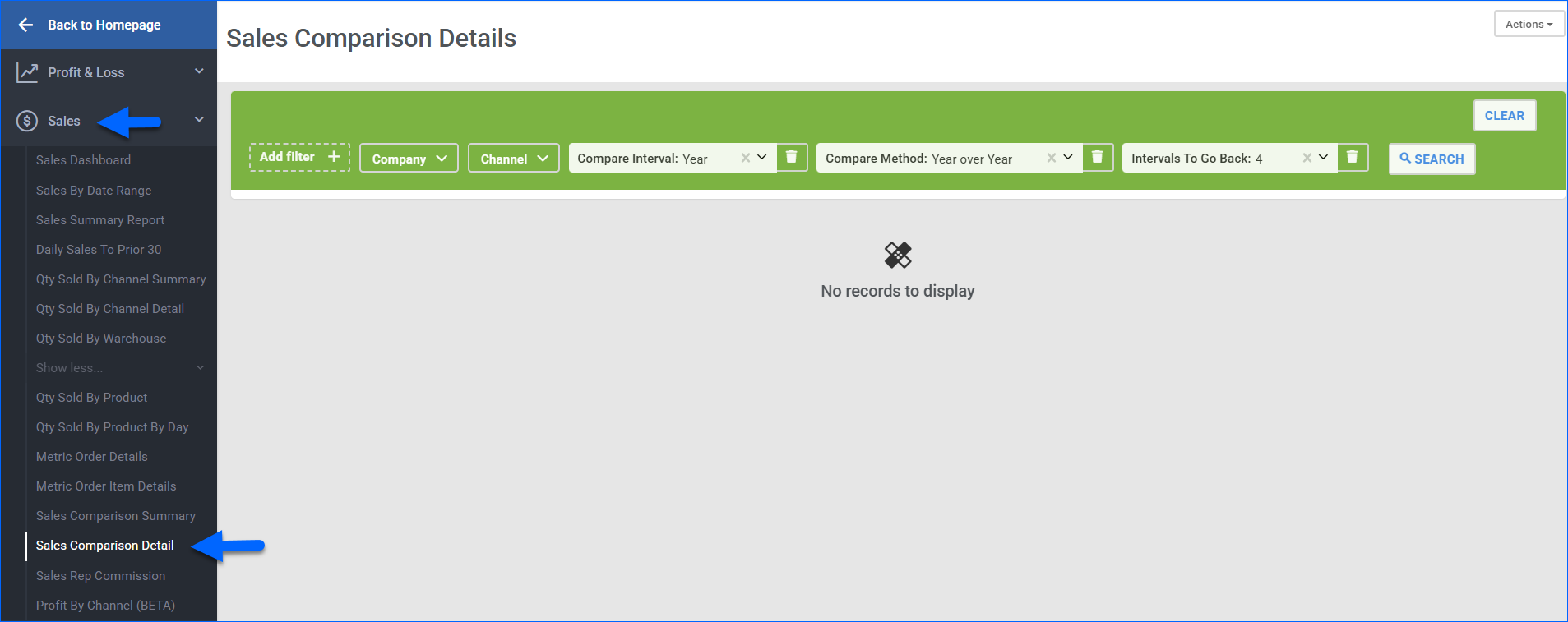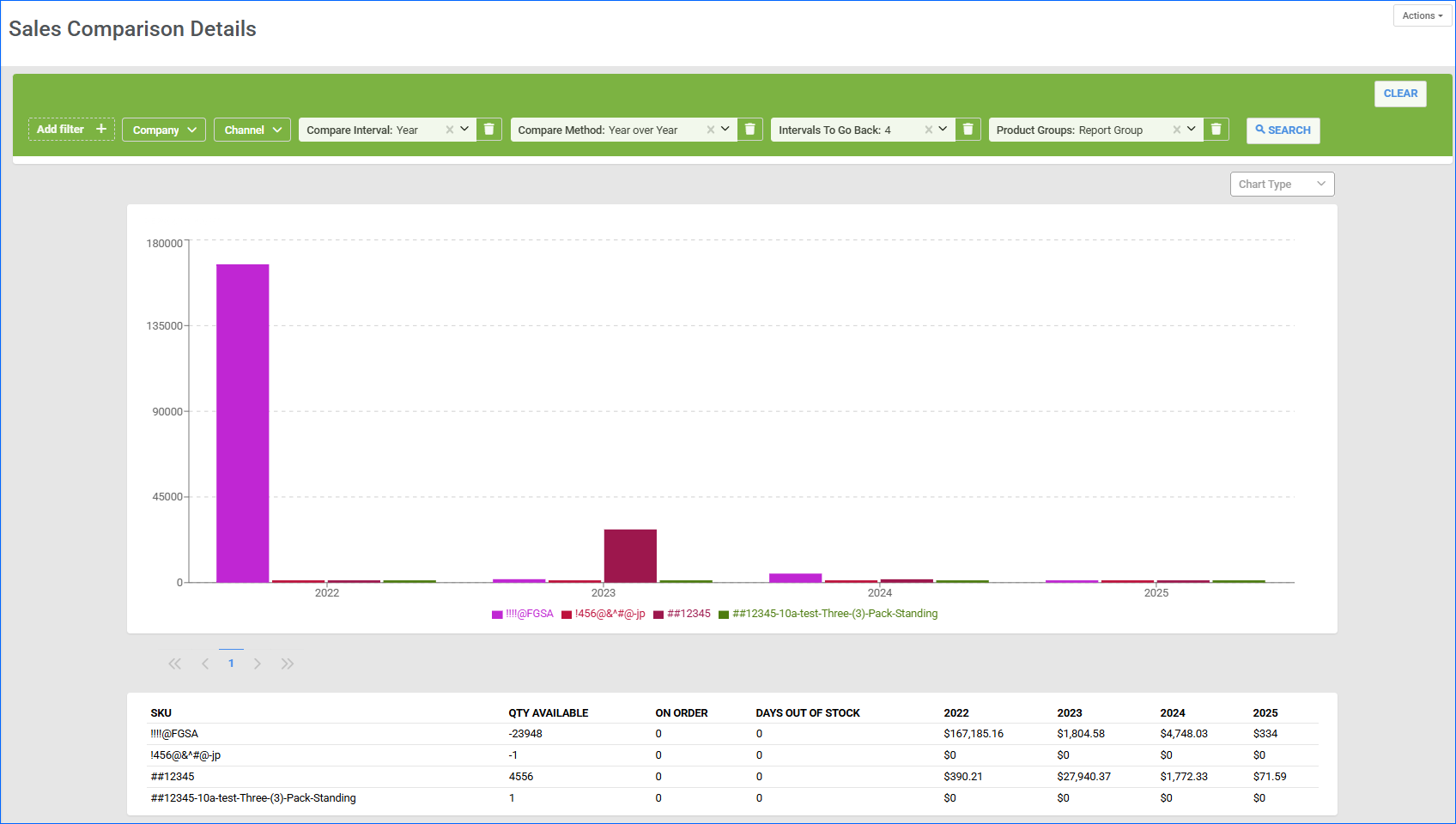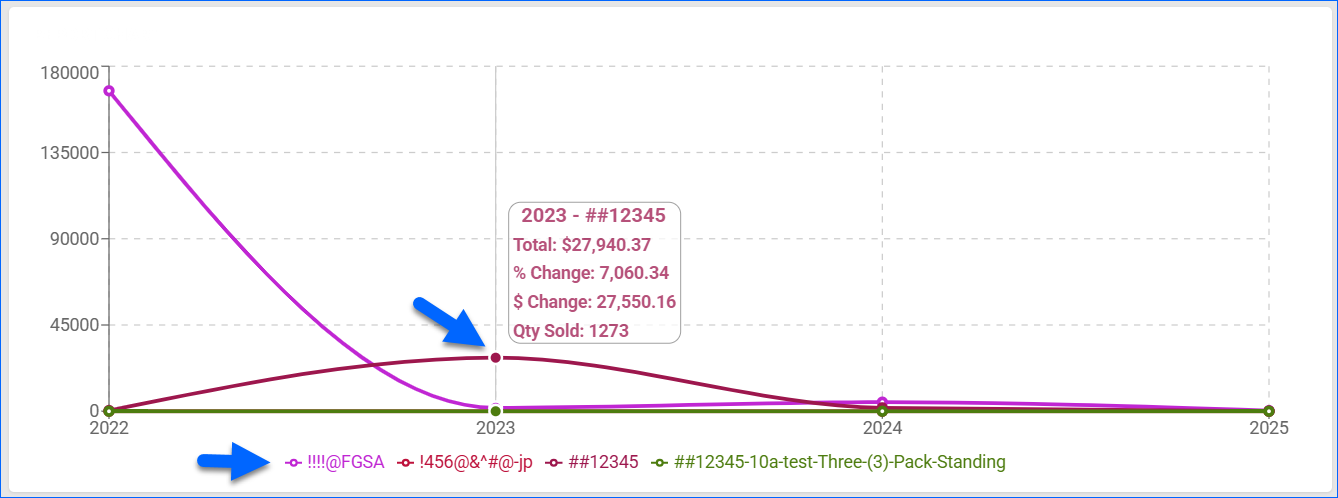Overview
In this article, you will learn about Sellercloud’s Sales Comparison Details report. It allows you to view the sales performance of your products during a specific time interval and compare the data to one or more similar, earlier intervals.
The Sales Comparison Summary report is similar but more focused on giving you an overall picture of sales performance, summarised by channel or company, rather than breaking it down per SKU.
Access and Customize the Report
To use the Sales Comparison Details report:
-
- Navigate to Reports > Sales > Show more > Sales Comparison Details.
- You can set up the filters according to your preference or use the ones selected by default. For more information, see the Filter Definitions section.
Filter Definitions
Below is a list of the available filters and their definitions. Some combinations are incompatible and will not pull any results. Additionally, the section below provides some examples.
- Company – Accepts multiple values. If you select a Company, only the SKUs associated with it will be pulled up when you run the report.
- Channel – Accepts multiple values. If you select a Channel, only the sales data from that marketplace will be included for each SKU pulled up by the report.
- Compare Interval – Show sales totals from specific time intervals. For example, selecting Year will total the sales data per year, while Quarter will total the data per quarter. The Custom Dates option allows you to use the Custom Range on filter to select specific From and To dates for the interval you want to investigate.
- Compare Method – Select how to compare intervals:
- Year over Year
- Quarter over Quarter
- Month over Month
- Week over Week (from Sunday to Sunday)
- Intervals To Go Back – Select how many intervals back you want to compare. You can go back over 53 intervals.
- Company Groups – If you select a Company Group, only the SKUs associated with it will be pulled up when you run the report.
- Product Type – If you select a Product Type, only the SKUs associated with it will be pulled up when you run the report.
- Product Groups – If you select a Product Group, only the SKUs associated with it will be pulled up when you run the report.
- Vendor – If you select a Vendor, only the SKUs associated with it will be pulled up when you run the report.
- Manufacturer – If you select a Manufacturer, only the SKUs associated with it will be pulled up when you run the report.
- Brand – If you select a Brand, only the SKUs associated with it will be pulled up when you run the report.
- SKU – Accepts multiple values. This filter allows you to search specific Products IDs.
- Display Comparison Indicators – Select Percentage and/or Dollars to change the information available in the graph tooltips.
Example Combinations
Below are some examples of how you can customize the report results to view and compare specific sales information.
Example 1
You can view and compare sales data for a specific date throughout the years. For example, if you have a regular promotion that happens on the same weekend every year for a specific brand on Amazon, select:
- Compare Interval: Custom Dates
- Custom Range on: the dates of your promotion
- Compare Method: Year Over Year
- Intervals To Go Back: up to 53
- Brand
- Channel: Amazon
This combination will show you the total sales made during your promotion dates for each year only for the SKUs of that brand on the specific marketplace. Similarly, you can view dates throughout months or quarters.
Example 2
The Sales Comparison Details report allows you to compare the current Month or Quarter sales each year. If you select Compare Interval: Month and Compare Method: Year Over Year, you will see the sales performance of the current month in each year.
Incompatible Filters
Some filters in the report are incompatible. Usually, this is the case when your selection in the Compare Method filter is shorter than the Compare Interval. For example, you can’t compare quarter over quarter when your interval is a year.
The following filter combinations are incompatible and will not be available to be selected together:
- Compare Interval set to Year and Compare Method set to:
- Quarter over Quarter
- Month over Month
- Week over Week
- Compare Interval set to Quarter and Compare Method set to:
- Month over Month
- Week over Week
- Compare Interval set to Week and Compare Method set to:
- Quarter over Quarter
- Month over Month
- Compare Interval set to Month and Compare Method set to Week over Week.
- Compare Interval set to Custom Dates and Compare Method set to Quarter over Quarter.
Report Data
The report data is based on the selected filters. It is available as a graph, a results grid, and an export in Excel, CSV, and PDF formats. Each one provides specific insights into the same data. Refer to the sections below for more information. The example report in the screenshots has the following filters:
- Product Group: One group consisting of 4 SKUs.
- Compare Interval: Year
- Compare Method: Year over Year
- Intervals To Go Back: 4
Report Graphs
The Sales Comparison Details report offers two data visualization options: Bar Chart and Line Chart. You can toggle between them by selecting options in the Chart Type dropdown. The graphs are based on the filters you have selected and display additional information, such as dollar and percentage change of the totals from each interval. The visualization also allows you to easily compare not just performance across intervals but also the performance of different SKUs within the same period.
When comparing multiple products, you can click on the SKU below the graph to exclude it from the visualization.
- Bar Chart – hover over a bar to view the total sale amount and the percentage and/or dollar change for the selected operation and interval.
- Line Chart – hover over the dot where the operator name crosses the interval line to view the total sale amount and the percentage and/or dollar change for the selected operation and interval.
Report Grid
The report grid is based on the selected filters. The column headers are the compare intervals (year, quarter, month, week, dates), and the Intervals To Go Back determine the number of columns. The rows are based on which SKUs match the criteria of your filters. The grid shows the total dollar amount of sales for each interval.
The data in the Qty Available, On Order, and Days Out Of Stock columns is calculated every night outside of business hours. Due to any inventory movements that happen between the overnight calculation and the time you run the report, there may be a discrepancy between those numbers and the live data.

Export Data
To export a Sales Comparison Details report:
- Configure your filters.
- Click Search to load the results.
- Click Actions in the top right corner and select:
- Export To Excel
- Export To CSV
- Export To PDF
- The file will download to your device.
The export will contain a combination of Grid and Graph information, as well as some additional details. The first columns are Product ID, Product Name, ASIN, and ProductType. They are followed by the current Inventory Data. Subsequent columns are based on the selected filters. You will see the total dollar amount for each interval, the percentage and/or dollar change from the previous one, and the related Average Sales Price.




